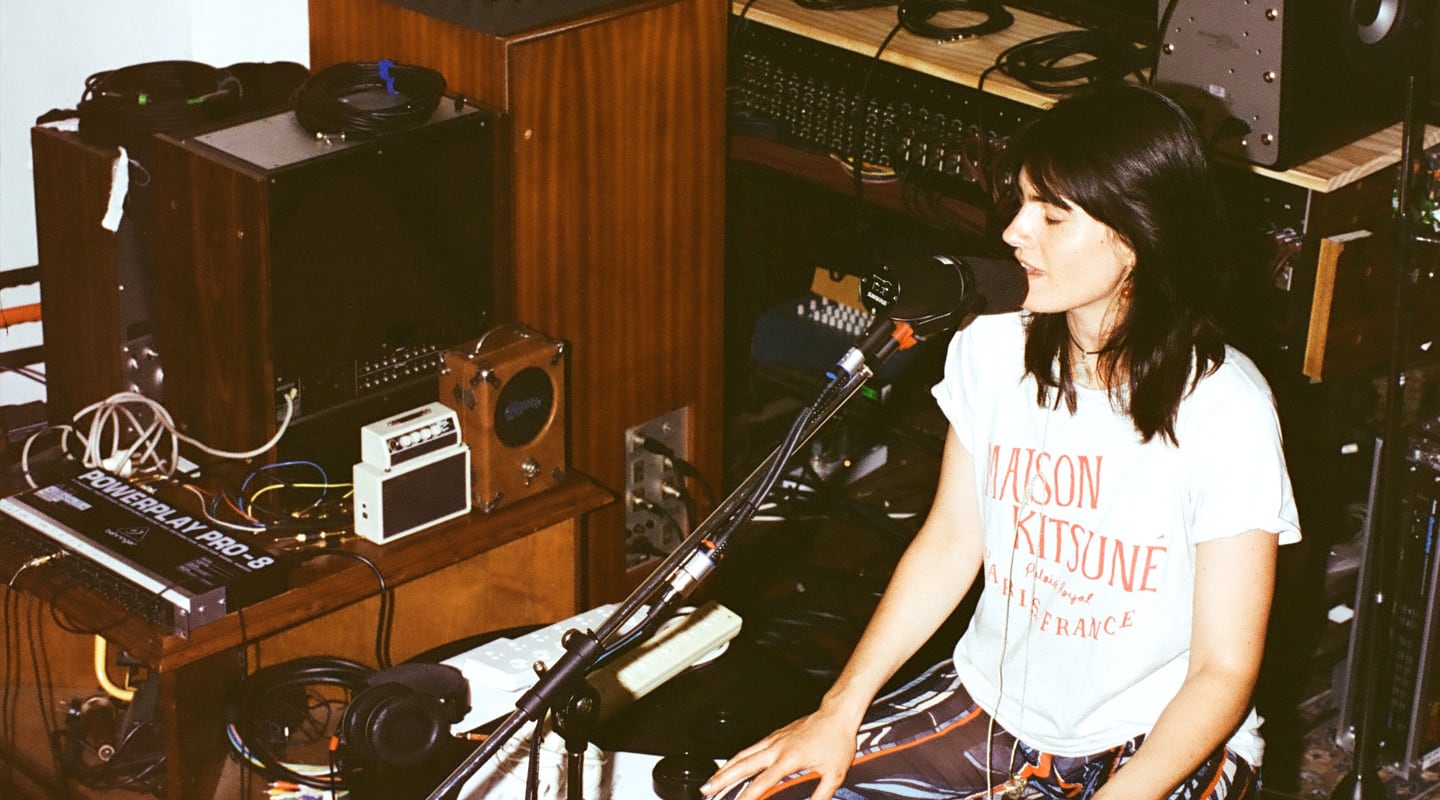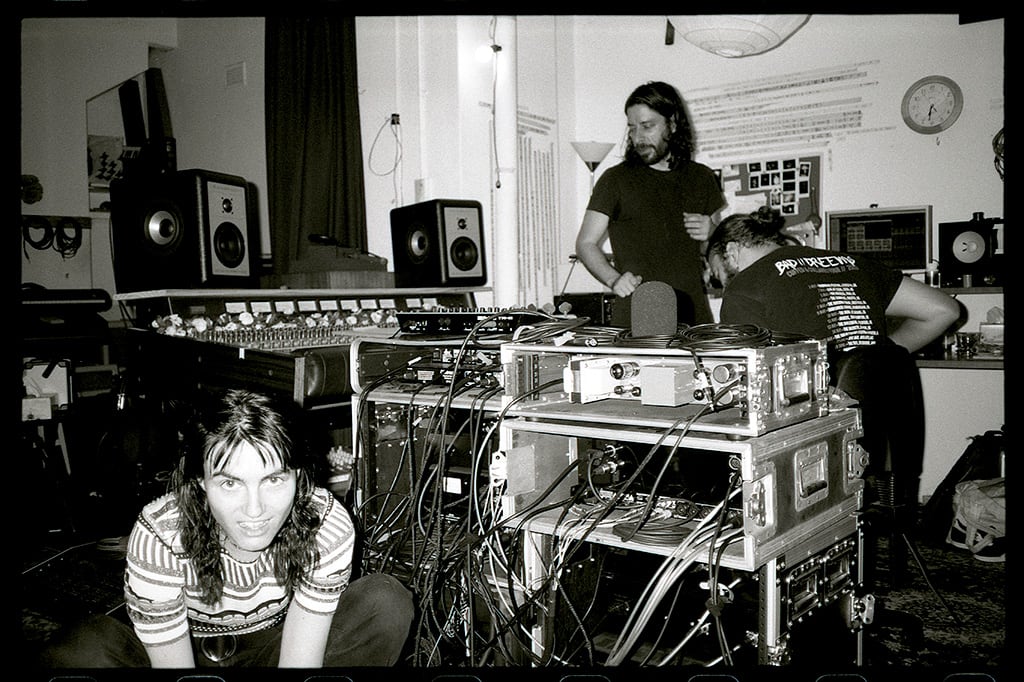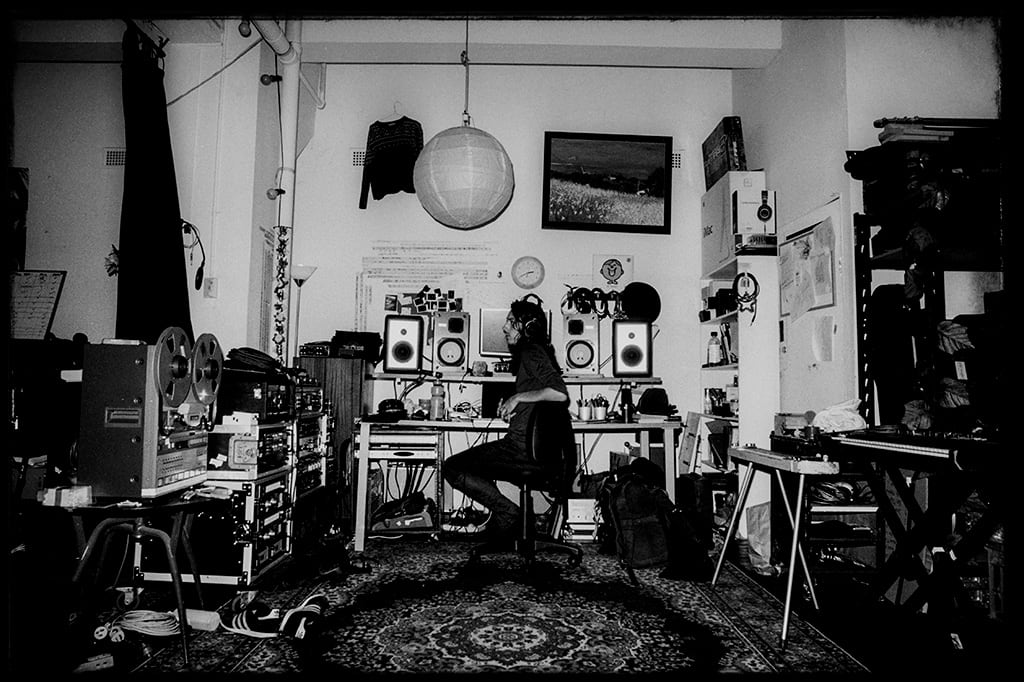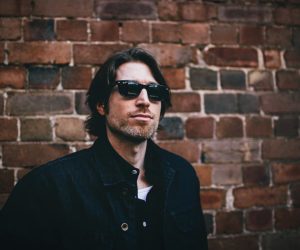
Preatures Escape Doldrums with Clearmountain
Preatures guitarist and producer, Jack Moffitt, DIY records the band in their own studio, Doldrums. Flying solo can become a trap Moffitt gets caught in, but mixing with Bob Clearmountain opened his eyes to collaboration.
I’ve brought The Preatures’ producer/guitarist, Jack Moffitt, to a BBQ joint… and he’s a vegan. It was a rough start, but he feigned a real interest in his bowl of house-made pickles like a true gentleman and we got stuck into the beer and conversation.
Around five years ago, he and fellow Preatures, including vocalist Izzy Manfredi (who’s guested on a couple of Flume tracks, including the Holden ad-powering tune Trust), set up camp in a Surrey Hills warehouse. “It’s one of those innocuous buildings near Central Station,” said Moffitt, who explained it’s been in the hands of the Sydney music scene for some time. “It was a performance space called Doldrums [a name they’ve kept] where we used to go see bands play. It was run by a friend of ours who moved away and Seekae moved in with Ghoul. Then Izzy became friends with Alex Cameron from Seekae, who were thinking about moving on from it.”
Originally it remained a collective; Seekae’s John Hassell was living there at the time, and the space was split between Seekae, The Preatures and another band called Bear Hug. When the others vacated, The Preatures took on the lease, Moffitt pooled his collection of gear and they began recording demos for their EP, Is This Is How You Feel?.
Five years on, and the Preatures have turned it into their own creative hub. “Izzy has a little office as you walk in the door,” described Moffitt. “She’s a writer, and great with keeping up correspondence with other bands, the label, management. Then our bass player Tom — who’s also a photographer — has his office, which is a shit fight with cameras everywhere. Beyond that there’s a lounge, and from halfway across the room to the end is the live room with my gear, instruments, mics, pianos. It’s like Wilco’s Loft, but not nearly that much stuff.”
SELF-ENGINEERING GIRLHOOD
Moffitt is a self-taught engineer, by necessity: “When I was in high school, it was a near impossible achievement to get into a studio because no kid has $500.” Starting with the school’s Yamaha eight-channel console and cassette deck, it was trial and error jamming on Hendrix songs, and he quickly gelled with the process. “It’s one of those generational things. Sometimes we think faster than we can do, so it’s better if we can just record it right there than have to remember it,” explored Moffitt. “That’s how our music comes across. It’s really architectural, polished and organised. It can be very immediate, and there are only so many layers of interpretation.”
The Preatures’ latest record Girlhood is a little like that. The similarly-titled lead track is a straightforward pop song with a modern urgency that sits somewhere between the Divinyls and Arcade Fire. It samples from the last 50 years of pop, while keeping a real Australian-ness to the record. There’s an ’80s grandeur to the meter of second track The First Night. Yanada incorporates aboriginal language and has an ABBA-esque groove, but the guitars and drums sound a bit like The Church. The pop-rock sampling is all anchored by Manfredi’s stunning knack for simple pop melodies and a confidence in delivery that makes the songs hers. “Izzy and I had been talking about the idea for ages,” said Moffitt. “This balance of harmonies and contrasts about being a woman and expressing that through her songwriting while being in a band surrounded by men supporting that intention with masculine energy. Girlhood is the sound of a group being driven by the awareness of the songwriter who happens to be female. Not to try and think like a woman, but how do we get out of the way and let that run to the front?”

He bankrolled this hopeless bunch of kids and gave us the keys to a very expensive, well-kitted out studio, and told us to go for it
HARD PATCH
Moffitt has figured out his own methods of production along the way. It made the process of recording their first album Blue Planet Eyes with Spoon drummer, Jim Eno, a lesson in learning to work with others. Moffitt felt the pressure to have the rest of the album come up to the standard of their runaway success with single Is This How You Feel?, but he didn’t know how to communicate his way of doing things to Eno. To his credit, Eno “was so encouraging and gracious,” said Moffitt. “He knew what his responsibilities were but also just let me f**k up, or get out there. I’m so grateful we did that with him. I could imagine if we had done it with somebody with a difficult ego, we probably would have had a really shitty time.”
At Doldrums, Moffitt has all the space and time he needs to hang himself. He likes to keep things simple; 16 tracks, six microphones on the drums, and everything hard patched. “I read an AudioTechnology interview with Philippe Zdar, and his mix setup was basically hard patched chains that he hardly ever changes,” explained Moffitt. “It relieves me of a whole bunch of crawling around on the floor, trying to connect mic eight to channel six.”
The instruments are set up like a show; drums down one end near the window, bass off to the right, guitars off to the left and a PA for Izzy that he occasionally uses to reamp drums. All of it runs into a multicore to his gear at the other end of the room, ready to record. Whether it’s re-cutting a song they’ve been sitting on for two years or jamming out a new track late at night, they can always wait until the time feels right: “Your Fan was just Izzy jamming a new idea for the song, the microphones were up and I hit record.”
For a long time it was all hooked up into an eight-track machine, but it “wasn’t going to be enough tracks,” said Moffitt. “I ran out of tape and didn’t have any money to pay for more, so it was all back into Logic and the computer.”
Then when Burke Reid came by to help on the sessions, he challenged Moffitt to learn Pro Tools. “His reasoning was spot on,” said Moffitt. “He said, ‘You’re really good at this and you obviously want to keep doing it, so why hamstring yourself by not knowing the universal software language of all studios? Just figure it out. It’s a computer game.’”
After a couple of weeks of hitting dodgy keyboard shortcuts and destroying sessions, he quickly got the hang of it. He did eventually get the eight-track going again, and still uses it to record drums. He loves the sound of it, but the loss of “modern immediacy” with tape compression is a trade off for Moffitt, who dreams of one day making “an album that sounds like Crazy, Sexy, Cool by TLC.”

MIC UP THE DOLDRUMS
Moffitt uses a Neumann U57 as a mono drum mic; sometimes overhead, sometimes where Izzy left it after a vocal take: “There’s a great node in the room where it sounded really awesome.” On rare occasions a couple of Coles 4038 ribbons would back up the mono mic with a stereo spread. A Shure SM57 was on snare, sometimes a Neumann KM84 for more snap, “but you can’t really go ballistic, because it’s gentle and would start to sound a bit shitty.” He had Sennheiser 421s on toms or occasionally a “weird little Telefunken TD200 that looks like a shaver.”
He’d also place a Geffell omni dynamic mic on the kick batter head. “Wayne Connolly showed me that technique. It gets kick batter and snare unders, so if you stomp on it hard enough with a compressor you get this great picture of the kit, but it moves outwards instead of forwards.” He would supplement that with a Telefunken M82 “no frills” dynamic mic and a Rode Classic on the outer. Sometimes he’d add a hat mic if required, usually an SM58 because it was all he had left. A lot of the mics are hard patched directly into API 312 preamps.
Izzy would sing guide vocals into a Shure SM7, leaving the guys to nail it after a couple of takes. From there it just became another room mic option. “Almost the whole drum sound of Lip Balm is the SM7,” said Moffitt. “That ganky, shitty-sounding, compressed room mic. It’s not new but it sounds awesome.”
Moffitt recorded the album on a 16-channel Lynx Aurora converter. Halfway through he got an Apogee Symphony I/O, but kept it out of the loop to keep consistency. He keeps a couple of channels spare for overdubs; two Neve 1073 preamps, one that goes into a Retro 176, and the other into an ELI Distressor. “You don’t really need anything else after that point,” said Moffitt.
Moffitt thought the guitars on the last record sounded like they “smeared around the drum kit.” This time he wanted them to be large, “voltage-wise”, with space around them. He ended up picking Alex Cameron’s brain from Bad Dreems about how Mark Opitz recorded their guitars (check out Issue 122 for more), using his 45-degree technique with a Neumann U87, in figure eight, and an Sennheiser MD421. “I blended them together with this little AWA line amp and printed them onto a single track,” said Moffitt. “The AWA has four inputs, but it only comes out in mono, which is awesome.”
He likes the sound of the U87 in figure of eight, because it also picks up the drums in the room, and when the band are laying down rhythm tracks together, the 421 on the floor tom also cops a little bit of the guitar. “It can be quite fun if you balance all your phase really well,” said Moffitt. “You do make some sacrifices but it feels cooler.”
When he wanted to keep things sounding upfront, he went direct in via a DI, then would run it back out into the room through a PA or guitar pedals. “I got some advice once to get everything out of the machine,” explained Moffitt. “I love that idea, so anything DI’d was running back out to something. Sometimes it was painful for the rest of the band. At the beginning I told them, ‘I’m going to go very deep. Sometimes I’m going to need you to stop me, other times I need you to leave me alone. I don’t know when that will be.’”
Moffitt gets caught up in sounds easily, deep diving into tonal inspiration from Radiohead’s Bodysnatchers, or Ryan Adams new record, anything British from the ’60s. “There was a week where I told everyone to stay away while I was trying to crack this guitar sound. People kept coming in and I was like, ‘Thank god!’ Because I was like losing my mind playing with sounds. It’s a definite trap.”

CLEAR AS A BELL
They band ended up needing to find a mixer in short order, having delayed the decision until the end of the album recording. Coming up short against other people’s schedules, it all fell into place pretty serendipitously. “We were listening to the radio in Perth and Let’s Dance came on, then Born in the USA came on, and then something else, and it was all Bob Clearmountain’s mixes,” said Moffitt. “They defined a couple of decades of music. Then Bryan Ferry came on and Izzy asked, ‘Who mixed this?’ I said, ‘Bob Clearmountain, he actually mixed the last three songs.’
“We both messaged our manager Andy, and he thought it was a great idea. The next day, Bob’s manager replied saying he was free to do it.”
The two of them went over to sit in the sessions with Clearmountain, and he was more than obliging. “He’s working on a G-series SSL, the same one he’s been using for the last 20 years,” said Moffitt. “It’s apparently the first 72-channel board SSL built, and they made it for him. He’s modified it a lot with different EQs, and a side-chain detector circuit in the comp which he’s modified to run in 5.1. He doesn’t have loads of outboard: a stack of 1178s, about six Distressors, a couple of Yamaha processors, and some other reverbs and delays including a Lexicon PCM80.
“He goes through mixes like a play, and finds the characters. It’s never in any particular sequence. He moves through the mix until he gets it to a place where he spins around in his chair and asks, ‘Well, how’s that?’ That’s the invitation for Izzy or I to go sit with him at the VCAs automating and changing sounds.
He never did anything wrong. He’s very responsive to personal energy. After we got over our sort of awkward ‘getting to know you’ phase, he was really sensitive to our ears by the end.”
YOUNG & ANACHRONISTIC
Mixing the record in the States with Bob was an eye-opening experience for Moffitt in more ways than one. While he was there, he was able to tour the Apogee facility, meeting Apogee CEO, Betty Bennett, who also happens to be Clearmountain’s wife. He got a sense of a unique balance of masculine and feminine energy under Betty’s leadership with Bob’s input into the technological development, drawing parallels between himself and Izzy. The notion of the idea being king whether it comes from inside or outside the company also struck Moffitt. After being heavily DIY for so long, “those kinds of ideas are exciting Izzy and I a lot more,” he said. “Having more people involved, and the right people involved at the right time. It’d be nice to trust some people for their abilities. Maybe I could be a musician for a while.”
He referenced Making Rumours — engineer Ken Caillat’s memoire about the classic Fleetwood Mac album — and the conundrum of trying to be both a musician and producer. “He was just an engineer brought on to do the gig, and the band started asking him for his opinion,” recalled Moffitt. “He asked them if they wanted to come in and listen. I think Christine said, ‘I don’t want to have to f**king come in and listen. I want you to tell me how it is because I’m out here trying to do the music and you’re supposed to help me not have to lose my vibe.’”
Moffitt feels pretty positive about that gap reducing between being a musician and a producer. “There are so many little barriers and little frustrating hurdles in producing music which are gradually being removed by technology,” said Moffitt. “Speaking to people like Bob and Betty, there’s always a place for where we came from and what we did, but there’s also a greater world out there of people who don’t want to be prohibited from being creative.
“We’re going through a boom where consumer electronics are crazy tech. I’m the oldest of four and my youngest sister is 14 growing up with all this shit. I genuinely feel like I’m an anachronistic pivot point from a generation where comprehension was built around a certain method. These kids will undoubtedly grow up to do some crazy stuff.”



























RESPONSES